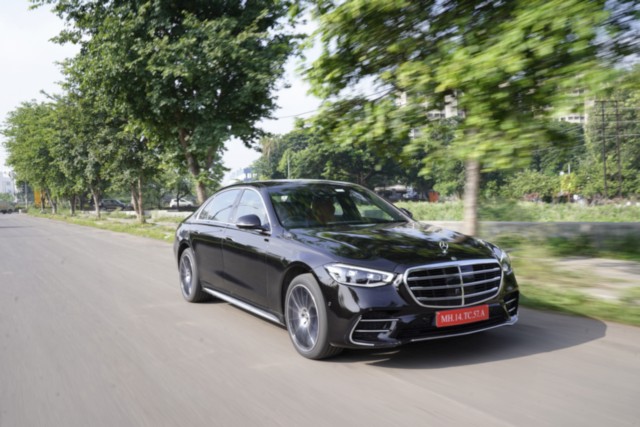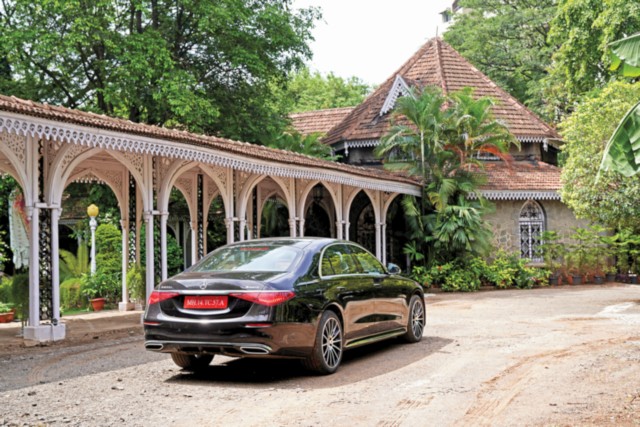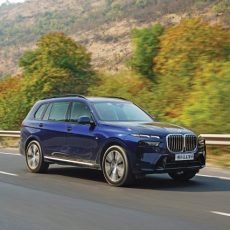The Mercedes S-Class is a big car and it feels like one. The in-line six, mounted longitudinally over the front axle, and the four-wheel driveline put the weight low and across. It’s over two tonnes but the motive force on tap is plenty. The 700 Nm of peak torque kicks in at just 1,200 rpm and stays till 3,200 rpm. The 9G-Tronic automatic transmission shuffles ratios with ease and keeps it going in the optimum band for the best balance of fuel consumption and driveability. Rarely did I see more than 2,000 rpm; or the need for it. The wallop is generous everywhere in all gears. And there’s no engine noise in the cabin. Modern diesels are only getting better. Not less expensive, no. But better.

The driving is aided by a slew of electronics. From adaptive cruise control — is it still called Distronic+? — to autonomous emergency braking, the S packs everything from the Mercedes safety repertoire. The active bits most noticeable are the blind-spot assist, lane-keeping assist, active steering assist, and auto-brake; all of which can be turned off. The blind-spot alert isn’t just a little light in the wing mirrors, it also uses the active ambient lighting, which uses an additional layer of light units with around 250 diodes that are integrated into the driving assistance systems, to visually reinforce their warnings. The other useful systems are the 360° surround camera and the parking aid. There are what appear to be sensors in the info-display behind the steering wheel to analyse the driver and assist the, um, Attention Assist system. There is even a guide with dots for adjusting the steering wheel. Phew.
There’s a lot more. The latest generation Driving Assistance Package, offered as standard, has several new and many improved functions, one of which is the intelligent compliance with speed limits. The new assistance display in the driver’s info-display clearly shows the driving assistance systems in full-screen view. Another big plus is the rear-axle steering. It makes the S-Class far more manageable in the city, especially when dealing with narrow streets and sharp corners. It makes it easier to manoeuvre by turning the rear wheels by up to 10 degrees. At low speed, the wheels turn in the opposite direction as the steering wheel, reducing the turning circle by up to two metres. At speed, they steer in the same direction.
There is clearly a lot that has gone into the new Mercedes S-Class. The hours gone into the design, development, tuning, and fine-tuning of all the components, systems, and equipment are evident. There is an orchestrated brilliance that brings about a natural coherence to the senses, in the multitude of elements that catch one’s eye or get one right in the feels. The S is poised to dominate the segment, gracefully, and, for now, no one else really has an answer. Yet.

Mercedes S-Class (S 400 d L 4MATIC)– Need to Know
Price: Rs 2.17 crore (ex-showroom)
Engine: 2.925 cc, in-line six, turbo-diesel
Max Power: 330 hp @ 3,600-4,200 rpm
Max Torque: 700 Nm @ 1,200-3,200 rpm
Transmission: Nine-speed, automatic, all-wheel drive
Suspension: Double wishbone front, multi-link axle rear, air springs
Weight: 2,090 kg
TECH: Driving Assistance Package

Advanced assistance systems can make a huge difference in everyday traffic and can relieve driver stress when required by adapting the vehicle speed, controlling distance, steering, and lane-changing. This allows the driver to stay alert for longer and reach the destination more safely and comfortably.
The S-Class needs figurative eyes and ears to perform all these tasks — a suite of sensors — and the S has all of these on board with the standard Driving Assistance package:
• Front multi-mode radar: two radar sensors with a 130° aperture angle
• Front long-range radar: one radar sensor with a range of 9° to 90°
• Front stereo multi-purpose camera: one camera with a 70° aperture angle
• Rear multi-mode radar: two radar sensors with a 130° aperture angle
• 360° camera (close range): four cameras with a 180° aperture angle
• Ultrasonic (close range): 12 sensors with a 120° aperture angle




